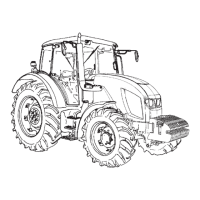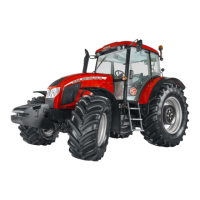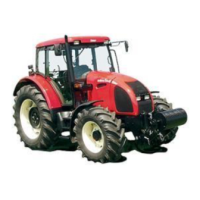
Do you have a question about the Zetor FORTERRA HSX 100 2014 and is the answer not in the manual?
| Engine Power | 100 hp |
|---|---|
| Hydraulic System | Open center |
| PTO Speed | 540/1000 rpm |
| Fuel Tank Capacity | 120 L |
| Engine | Zetor |
| Hydraulic Pump Capacity | 60 L/min |
| Engine Type | 4-cylinder turbocharged diesel |
| Displacement | 4.0 L |
General rules for safe tractor operation and adherence to local traffic laws.
Procedures and safety precautions for starting the tractor's engine.
Safety guidelines for operating the tractor, including brakes, steering, and road conditions.
Safety procedures for recovering a tractor, including warnings about chains and towing.
Safety guidelines to prevent fires, including refueling and battery inspection.
Instructions for performing daily maintenance checks on the tractor.
Safety warnings regarding interventions into the tractor's electrical system.
Instructions for checking the tractor's fuel system for leaks and tank drainage.
Procedure for checking and maintaining the engine oil level using the dipstick.
Checks for leaks and coolant levels in the engine cooling system.
Checking liquid brakes, clutch control, and brake fluid level in the expansion tank.
Checking oil level, screws, nuts, and hoses of the hydrostatic steering system.
Checking tyre pressure, adjusting it, and retightening wheel bolts.
How serious and less serious system faults are displayed on the dashboard.
Pre-operation checks to ensure safe driving conditions.
Step-by-step procedure for starting the tractor's engine using glow plugs.
How the tractor's synchronized gearbox, torque multiplier, and reversing are shifted.
Operation of the reversing lever to select travel direction.
Information on automatic gear shifting during dead starts based on engine revolutions.
Using the reversing lever for dead starts without clutch pedal.
Step-by-step guide for performing automatic dead starts.
Using the clutch pedal for stopping and delicate inching operations.
Detailed procedure for performing dead starts using the clutch pedal.
How to change the tractor's direction of drive safely.
Procedure for changing drive direction using the reversing lever at low speeds.
How to change drive direction using the clutch pedal with safety precautions.
Shifting gear speeds while traveling using the clutch control button or pedal.
How failures in travel clutches and gearbox systems are signaled by dashboard controls.
Indications and actions for serious failures in travel clutches and reversing systems.
Indications and actions for less serious failures in travel clutches and reversing systems.
Information on the three-gear torque multiplier and its control.
Using the switch to enable automatic multiplier gear shifting.
How the automatic multiplier shifting system operates based on engine revolutions.
How to switch the front drive axle on and off using the button.
How the front drive axle automatically disconnects at speeds above 15 km/h.
Engaging and disengaging the rear differential lock and its automatic switch-off conditions.
How system failures of the diesel particle filter are signaled by red controls and acoustic signals.
Procedures and conditions for diesel particle filter regeneration to clear exhaust gas temperatures.
Details on the hydraulic foot brakes, including pedal connection and use.
How a drop in air pressure is signaled and the implications for continued transport.
Procedure for stopping the tractor using the manual brake.
Steps for safely stopping the tractor engine after work.
Procedures for safely leaving the tractor, including securing against spontaneous start.
General principles for the initial 100 operating hours of a new tractor.
Safety precautions when working with the PTO shaft, including cover fixation.
Location and function of controls for front and rear PTO shaft operation.
How to preselect rear PTO shaft revolutions using the lever.
Using the switch to select rear PTO clutch revolutions (540/1000 rpm).
Engaging and disengaging the rear PTO shaft clutch using the switch.
Engaging the rear PTO shaft with independent revolutions based on engine speed.
Engaging the rear PTO shaft with dependent revolutions based on gear and reversing lever.
How the PTO clutch automatically disengages and engages based on hitch position.
Explanation of display values for setting automatic PTO shaft clutch disengagement.
Returning automatic PTO shaft clutch settings to factory basic values.
Procedure for setting automatic PTO shaft clutch disengagement parameters.
Safe operation procedures when using automatic PTO shaft clutch disengagement.
How to engage and disengage the front PTO shaft using the dashboard switch.
How the outer circuit supplies pressurized oil to implements via quick-couplers.
Procedures for connecting and disconnecting hydraulic quick-couplers with attention to residual oil.
Functions of individual positions of hydraulic distributor control levers (rear, central, front).
Identification and functions of electro-hydraulic control elements (lifting, blocking, speed).
Procedure to cancel blocking and activate the EHR-B electro-hydraulic system.
Two methods for controlling the three-point hitch: manual and automatic.
Procedure for manual control of the three-point hitch, including depth setting.
How the automatic control system adjusts to soil resistance for depth setting.
How diagnostic LED combinations indicate EHR-B system errors.
Detailed causes and locations of minor errors indicated by the EHR-B system.
Safety guidelines for working with the tractor's three-point hitch.
Step-by-step procedure for adjusting the toe-in of front driving axle wheels.
Table showing maximum liquid weight capacities for various tyre dimensions.
Essential service information for the electric system, including battery connection and starting procedures.
Maintenance procedures for the accumulator battery, including cleaning and electrolyte level.
Table detailing fuse positions, sizes, and the protected systems they serve.
Daily pre-start checks for the engine, cooling system, and brakes.
Maintenance tasks to be performed every 100 hours, including filter checks.
Table outlining filter replacement schedules based on hour reading.
Table specifying quantities of various operation liquids required for the tractor.
Table of hydraulic brake liquids, classifications, and mixing precautions.
Recommendations for cooling system liquids, including antifreeze and water mixtures.
Procedure for bleeding the hydraulic brake system for each wheel separately.
Steps for bleeding the rear brake system, including fluid level observation.
Step-by-step procedure for adjusting the foot brake pedal and its play.
Procedure for adjusting the parking brake lever and draw-bar.
Procedure for calibrating the digital dashboard's travel speed display.
Step-by-step guide for performing travel speed calibration on a marked track.
Table with technical specifications for Zetor Forterra HSX tractor models.
Table showing permissible load limits for the front axle based on travelling speed.
Table showing permissible load limits for the rear axle based on travelling speed.
Table showing the maximum permissible combined weight of the tractor and machine set.
Table detailing load-bearing capacities and inflation pressures for front tyres.
Table detailing load-bearing capacities and inflation pressures for rear tyres.
Table listing permitted combinations of front and rear wheel sizes.
Table detailing PTO power and engine output specifications for different models.
Data on the lifting force of the front and rear three-point hitches.
Table showing tractor speeds based on gear, multiplier, and rear wheel parameters.
Table showing PTO speed relative to engine speed for independent rear PTO.
Table showing dependent rear PTO shaft revolutions based on gear and engine speed.











